Albenga, a town on the western Ligurian Riviera, is a settlement of pre-Roman origin. Its first name was Albium Ingaunum, later Latinized into Albingaunum, meaning ’city of the Ingauni,’ from the tribe of Ligurians who had it as their capital. Its historic center, in which, in addition to the obvious urban layout of the Roman castrum, its flourishing medieval period is recognizable, preserves themost important early Christian building in all of Liguria, the baptistery, the only building left intact from late Roman and Byzantine Albenga. It stands at a lower level than the present city pavement, about two and a half meters, and is located next to the Cathedral of St. Michael, whose present forms are certainly later, but the location has remained unchanged from the original building.
The baptistery, whose architecture is still in the Roman tradition, was probably erected in the first half of the 5th century, thanks to the reconstructive work of Constantius, general of Honorius and husband of Galla Placidia, who was to become emperor in 421 under the name Constantius III. However, some new studies direct its construction between the second half of the fifth and the first half of the sixth century.
The plan is decagonal on the outside and octagonal on the inside. An octagonal drum, recessed from the roof of the lower body, rises in the central area, and eight single-lancet windows open on its outer surface. Among the windows in the lower area, four have a pierced and decorated stone slab as a closing feature. In the restoration of the 1950s, a fifth one was inserted, echoing the forms of the ancient one. In addition, two openings were closed by alternating bricks that allow air and light to pass through. The present roof is the result of a major restoration in the late 19th century, carried out under the general direction of Alfredo d’Andrade, director of the Regional Office for the Conservation of Monuments of Piedmont and Liguria. One of the interventions put in place was precisely the dismantling of the roof, believed to date from the 15th century. During this operation, some amphorae, traceable to the fifth century, were found, used to lighten the vault, which therefore was probably original: only the slate roof was perhaps later and was replaced by tiles in imitation of Roman ones.
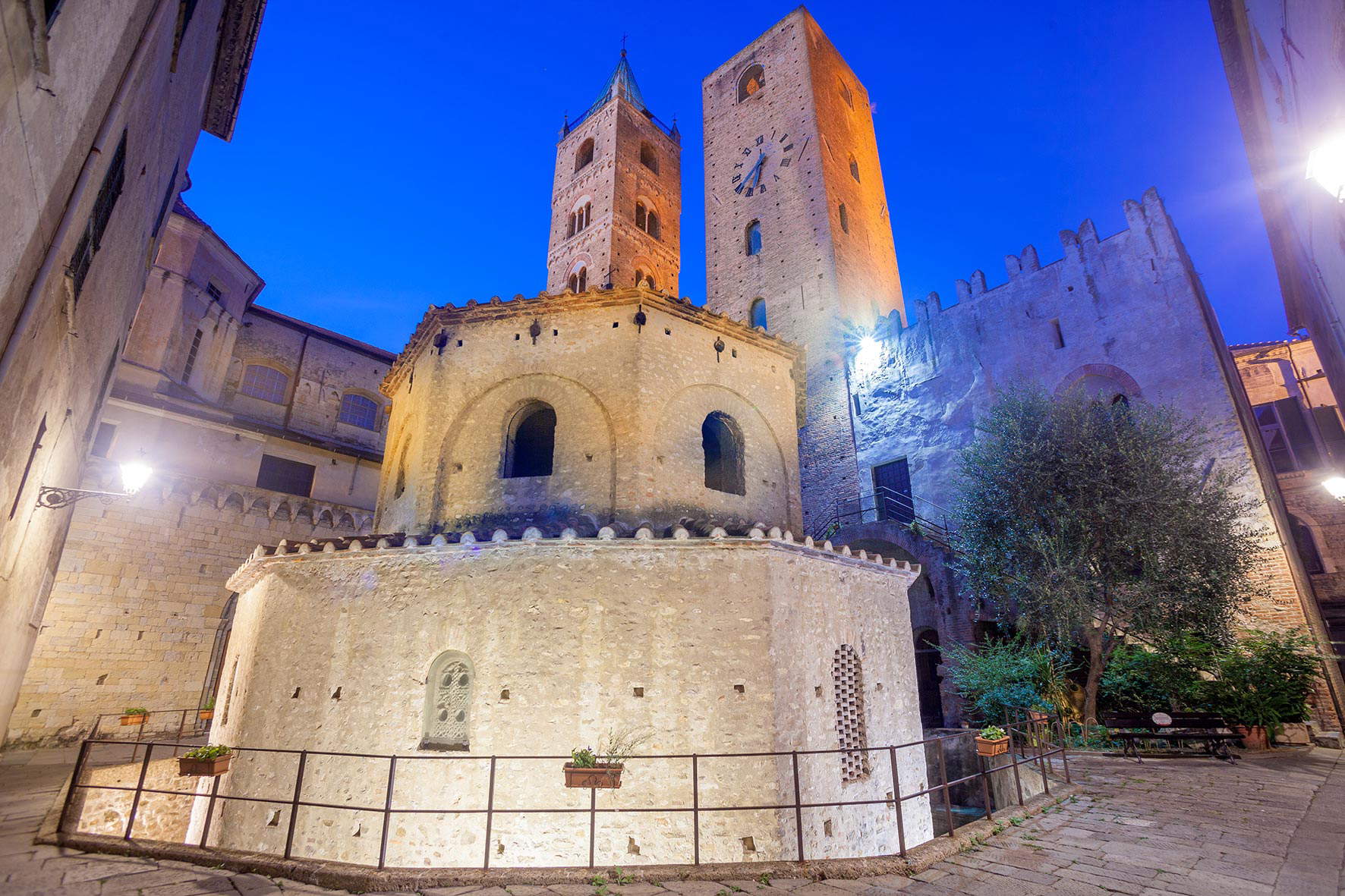 |
| The Baptistery of Albenga. Ph. Credit Mino Amandola |
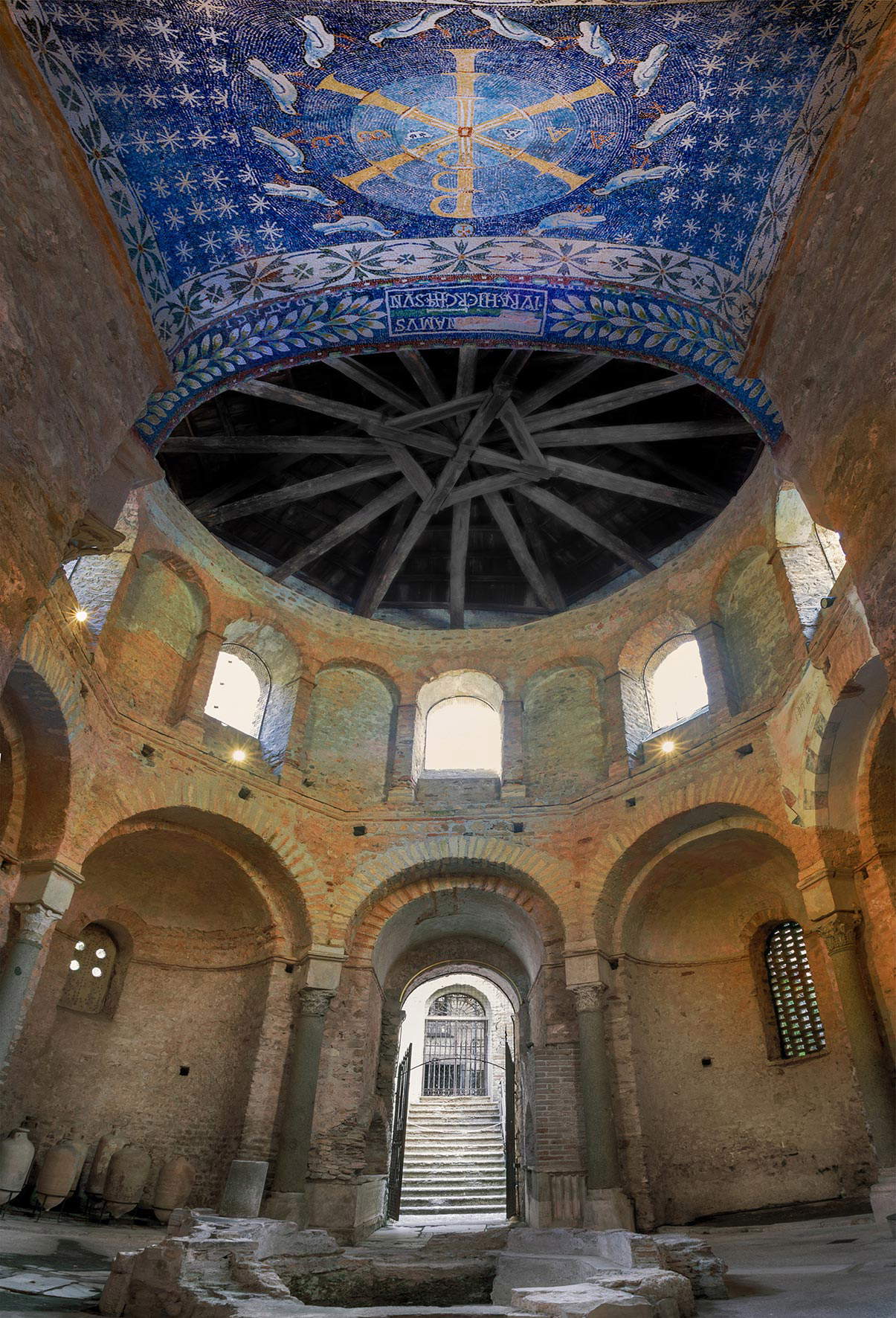 |
| The interior of the baptistery of Albenga. Ph. Credit Mino Amandola |
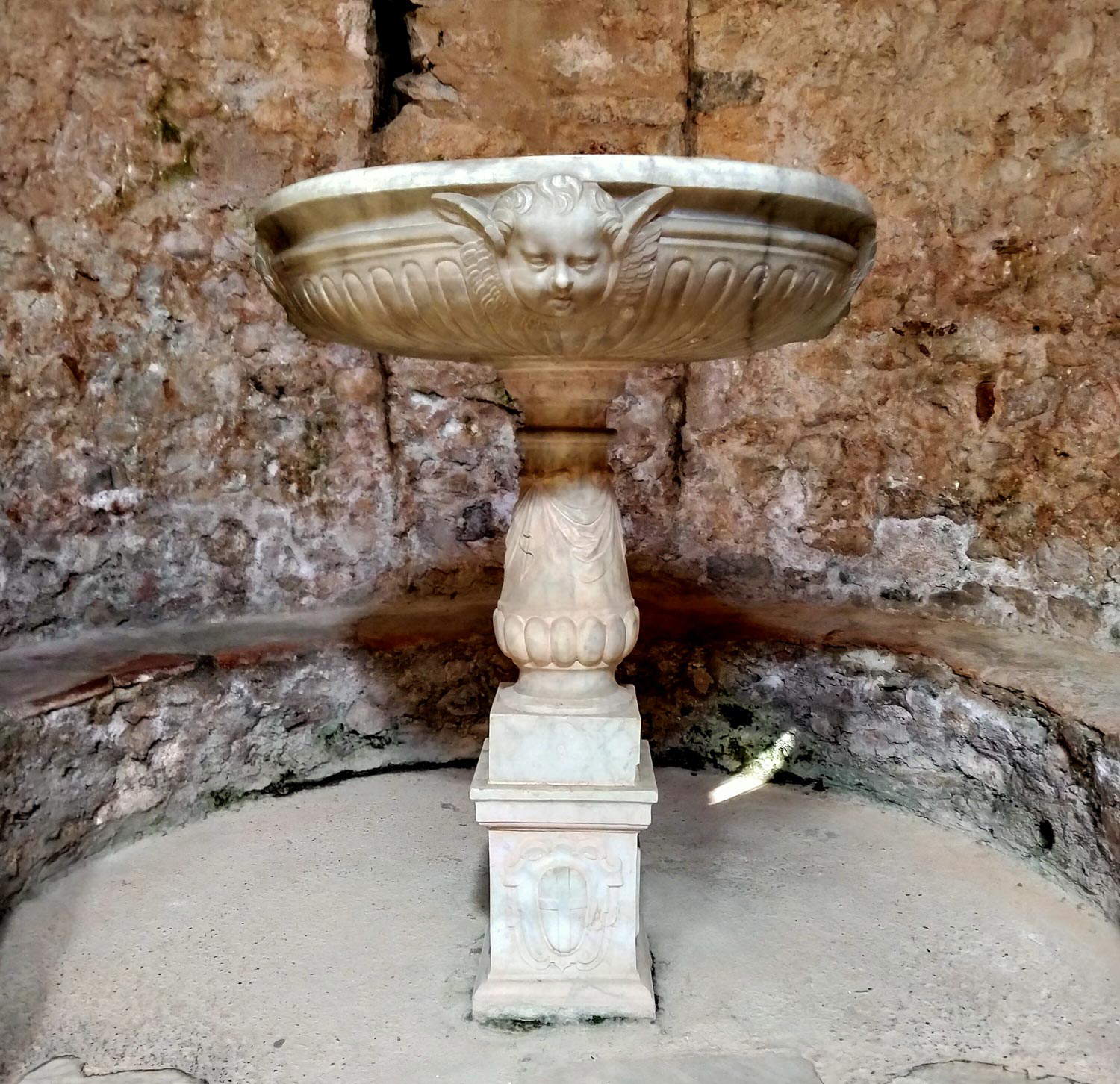 |
| Baptismal font commissioned by Bishop Luca Fieschi |
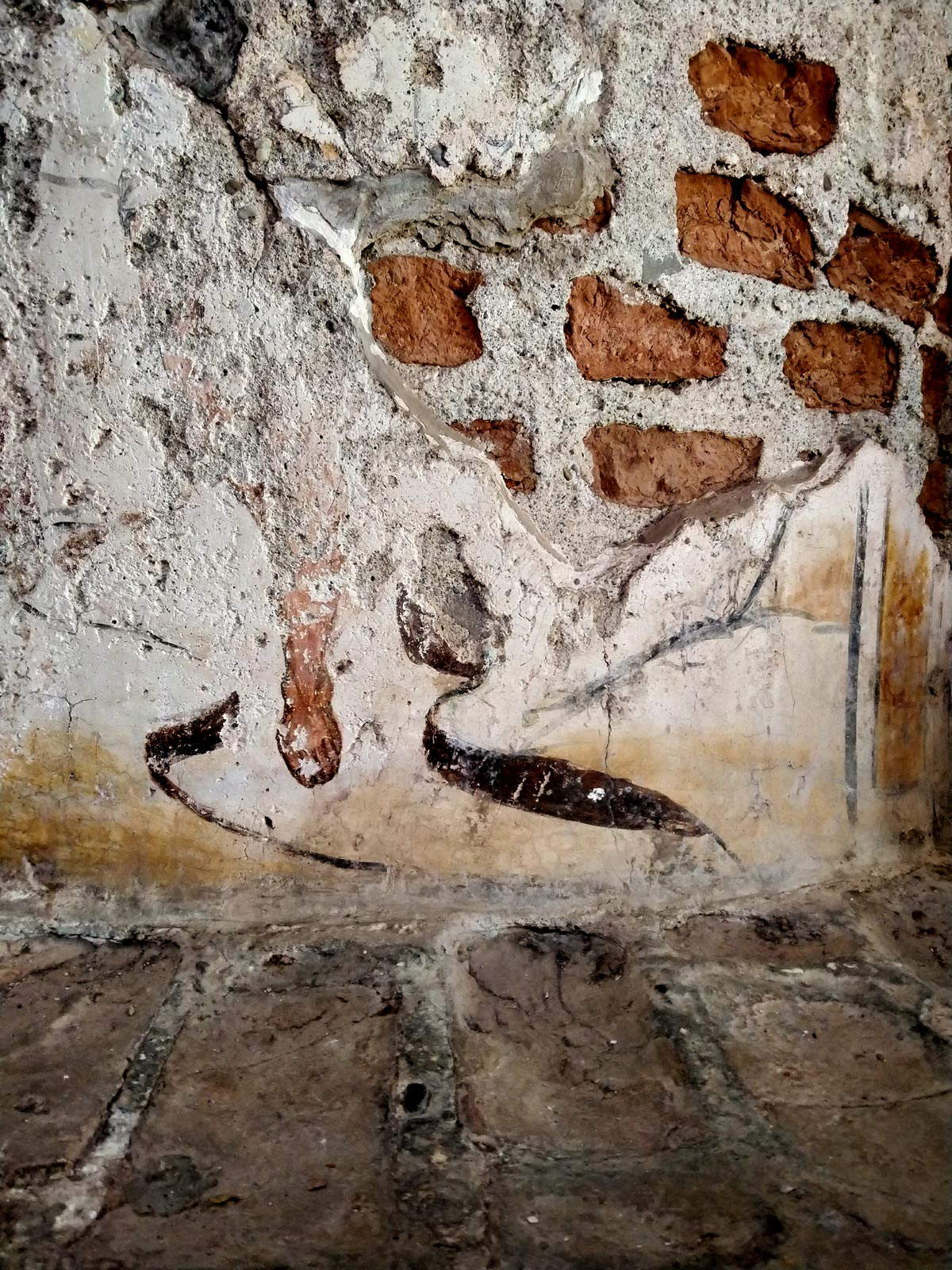 |
| Tear of pictorial decoration on the medieval baptismal font |
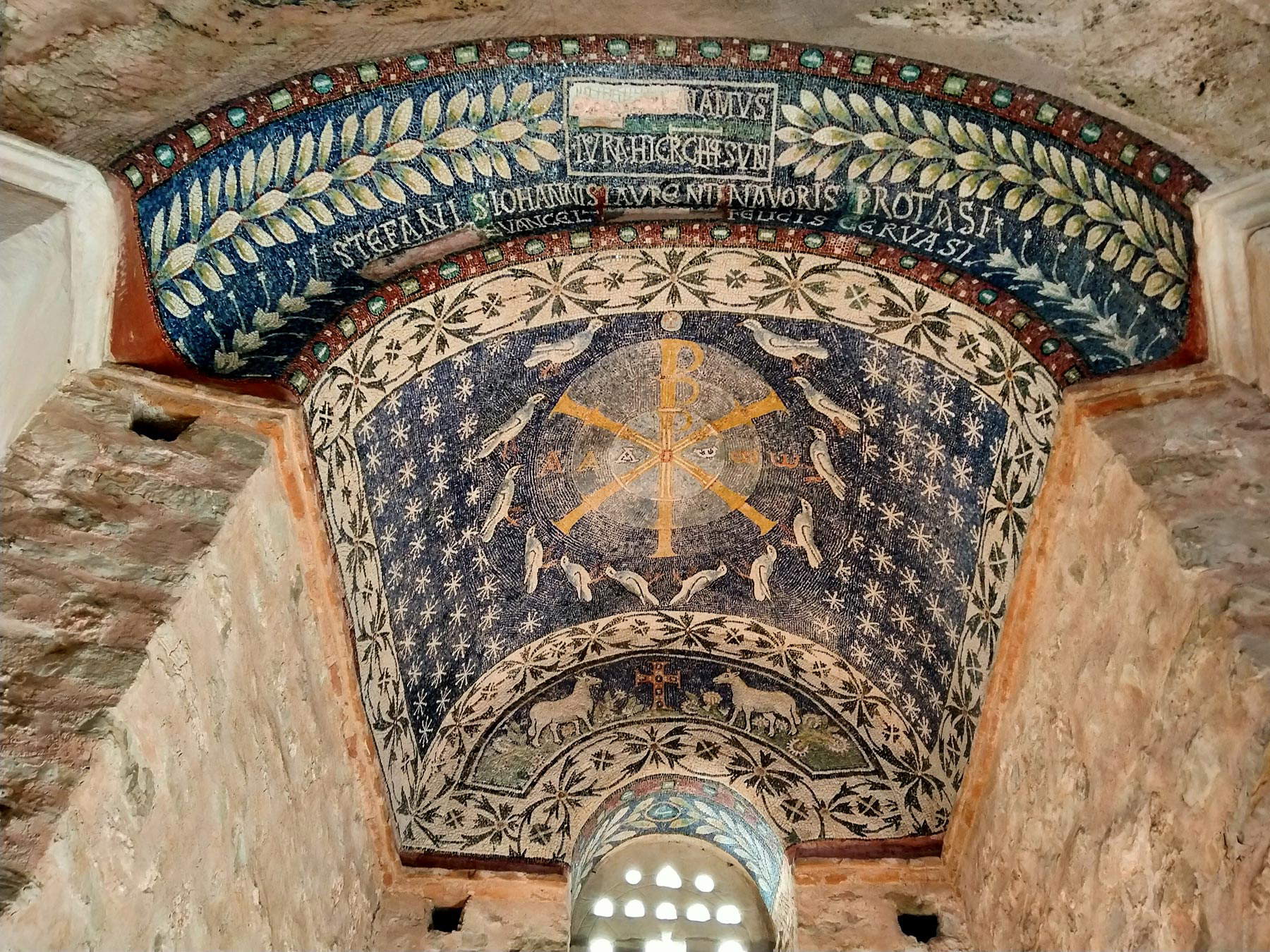 |
| The niche with the mosaic |
 |
| The vault mosaic in the niche opposite the entrance. Ph. Credit Mino Amandola |
Inside, square and circular niches alternate in the eight sides. At the corners are placed columns with Corinthian capitals. The center of the building has preserved the immersion baptismal font, which is also octagonal on the inside, while on the outside it is star-shaped. The number ’eight’ is employed inside baptismal buildings because Baptism is denoted by the eighth day, that is, the first day of a new week, just as for the Christian this sacrament is the beginning of a new era. Two later baptismal fonts are preserved in the two niches flanking the one containing the mosaic. One is cylindrical in shape, probably of medieval workmanship, positioned directly on the floor, and on the outer surface some traces of a representation of the Baptism of Jesus can be traced ; the other, in marble, was commissioned by Bishop Luca Fieschi (1582-1610), to comply with the indications of the Council of Trent, following the visit of Monsignor Niccolò Mascardi on the occasion of apostolic inspections.
Inside this baptistery is preserved a very precious testimony of early Christian art. It is a mosaic, which covers the surfaces of the vault, lunette and sub-arch of the niche opposite the present entrance. It is dated between the late 5th and early 6th centuries. Depicted on the vault is a blue sky studded with eight-pointed stars arranged in neat rows. In the center is reproduced the monogram of Christ, formed by the Greek letters chi and rho superimposed, within a circular halo of light blue hue. The monogram extends into two other concentric halos, which have a darker background tone. The letters alpha and omega are also repeated in each circle. In total therefore it is repeated three times. Surrounding the outermost halo are twelve doves, symbolizing the twelve apostles, which direct their gaze toward a small Latin cross within a circle positioned at the upper end of the outermost rho. There are slight differences in the depiction among the birds: those closest to the cross in fact have their tail feathers and wings open, ready to take flight (thus hinting at slight movement), while those further away are outstretched, waiting.
A wide band decorated with stylized acanthus leaves encloses the sub-arch and lunette. The latter depicts two lambs, on a flowery meadow, looking in the direction of a budded cross: it is an image of a heavenly setting. The background of this section is also blue. The sub-arch of the single lancet window of the niche is decorated with two laurel fronds, enclosing a small circle in which an anchor is depicted, and a band in red gemmated, a decorative motif that is also found contouring the surface of the exterior of the vault. Laurel branches are again found along with another white-flowered plant motif, enclosing a dedicatory inscription, as interpreted by Pietro Toesca early last century (although it is lacunose in places): (NOMI)NAMUS/QUORUM HIC RELIQUIAE SUNT. Below, it goes on to list the names of some saints, to be read from top to bottom: STEFANI S.IOHANNIS LAURENTI NAVORIS PROTASI / (lacuna) EVANGEL. (lacuna) FELICIS GERVASI.
It is likely that these names indicated the presence of the saints’ relics preserved in this environment. The cult of the named saints is linked to the Ambrosian Church (the diocese of Albenga was dependent on that of Milan). At the top of the wall, a fragment of mosaic can still be seen, where a dove and plant motifs can be seen. One can therefore imagine that the mosaic decoration also covered that entire surface, and a broader iconographic program than the one visible today cannot be ruled out. The central theme of this representation is the Trinitarian faith, together with the theme of Christ’s divinity. This necessity was the result of the contrast with Arianism, although at this chronological height the contrast had been exhausted. Indeed, Arianism supported the subordination of the Son to the Father, considering the Trinity to consist of three separate figures. In the Agaun mosaic the Trinitarian aspect is indicated by the repetition three times of Christ’s monogram and the apocalyptic letters alpha and omega. This iconography was particularly suited to the function of the place: in fact, those who were baptized here professed their faith in the three persons of the Trinity and, immersed in the central pool, could observe the mosaic before them. Workmen who were familiar with the innovations in the centers of the empire, either directly or through the circulation of cartoons, were probably employed to create this mosaic work. This depiction now lacks naturalism, as is evident in the flowers in the meadow of the heavenly vision, which have now undergone a strong stylization.
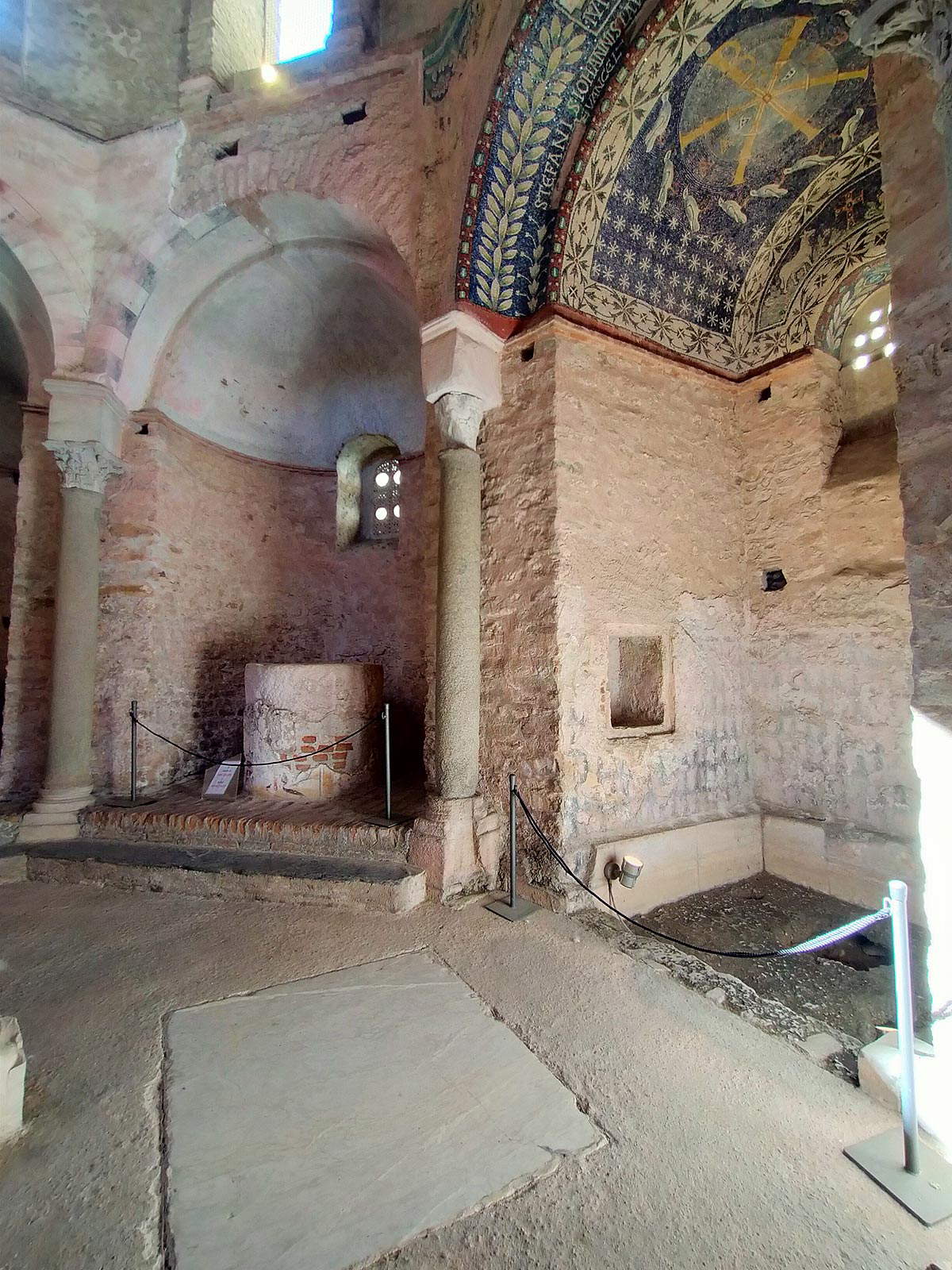 |
| The niche with the mosaic decoration and the niche with the cylindrical, masonry baptismal font |
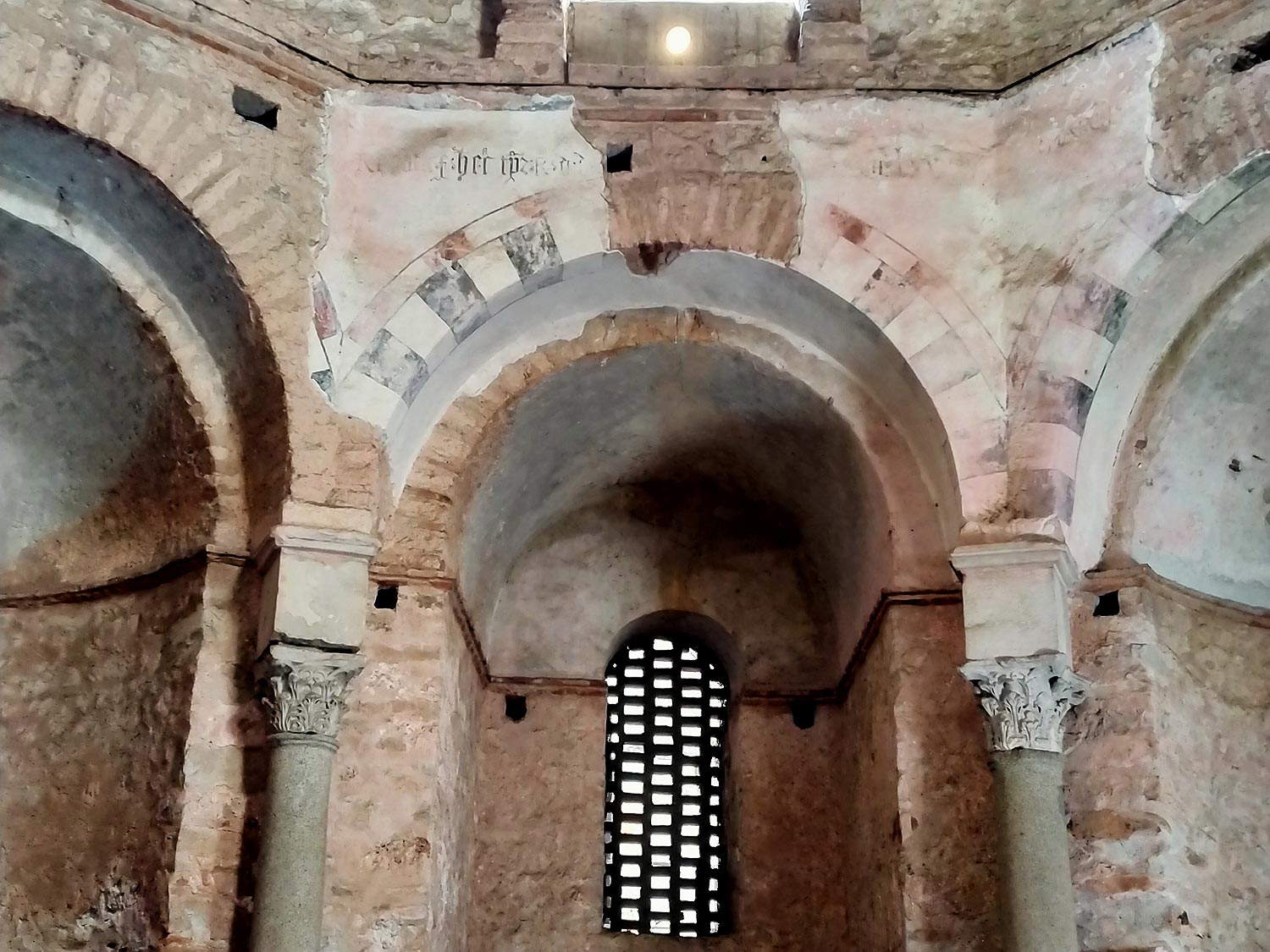 |
| Black and white decoration of the fifteenth-century work commissioned by Bishop Leonardo Marchese |
 |
| One of the arcosolium tombs on either side of the present entrance |
 |
| Amphorae (5th century) found in the roof covering in the late 19th century restoration work |
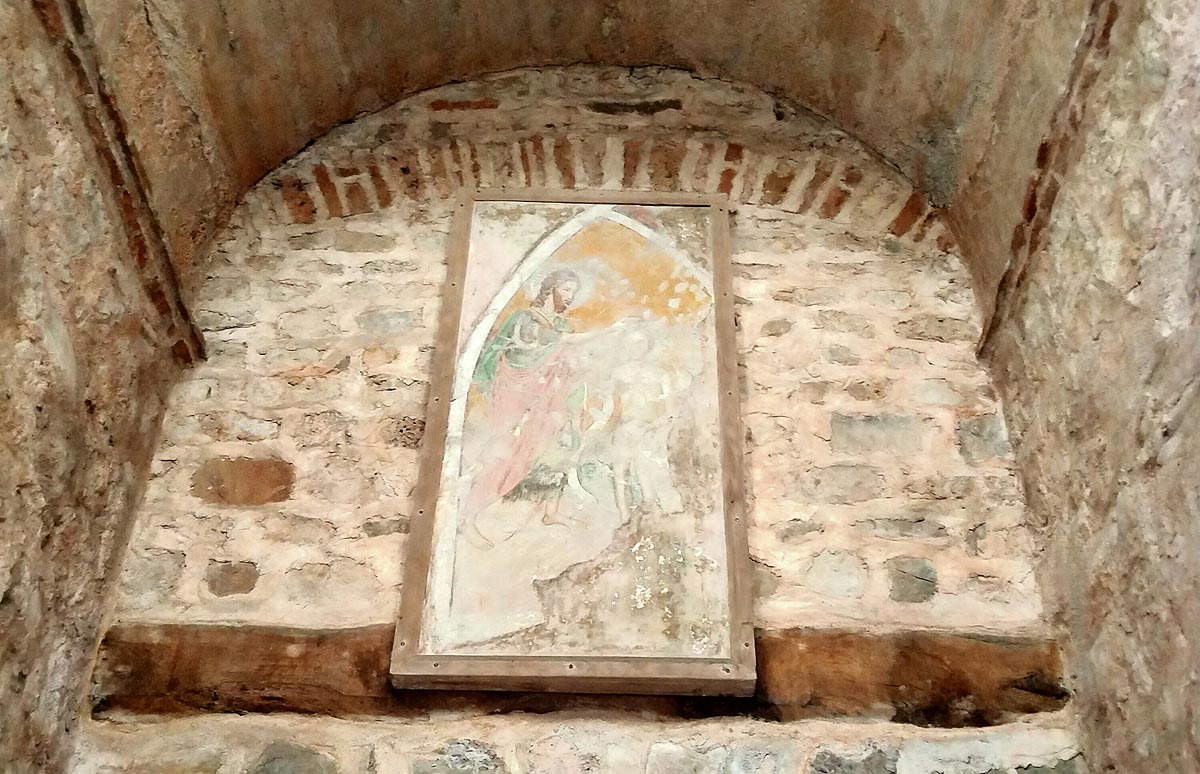 |
| Detached fresco depicting the Baptism of Christ |
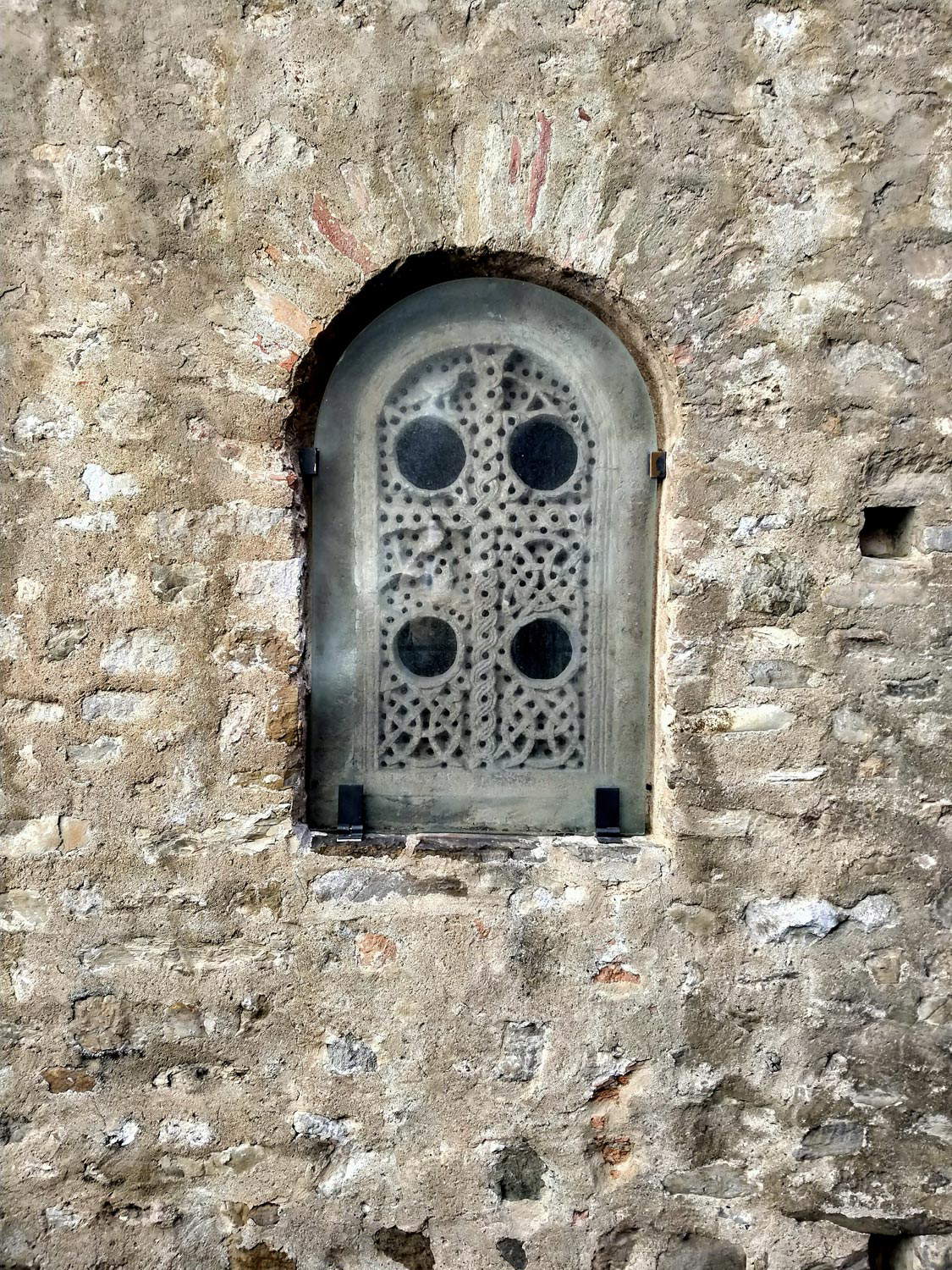 |
| One of the original windows |
In the Sacro e Vago Giardinello, a text written between 1624 and 1625 by Giovanni Ambrogio Paneri, secretary to Bishop Pier Francesco Costa (son of the banker Ottavio Costa), in which the churches of the diocese of Albenga were described, it was stated that at the end of the 15th century the baptistery was completely frescoed. Today few traces of the pictorial decoration are preserved, not all of which can be referred to the same period. A Baptism of Christ, probably made in the first decades of the 14th century, was detached during the early 20th century restoration and transported to canvas. Observing near the impost of the vault above the mosaic niche, other fragments of wall decoration are discernible, the execution of which is indicated as fifteenth-century, in which a face with a nimbus, another figure with a halo seen frontally and plant racemes are recognizable. Also preserved is a memorial inscription of Bishop Leonardo Marchese (c. 1445 - 1513), the commissioner of a fifteenth-century work (perhaps the one indicated in the above-mentioned seventeenth-century text), of which a short piece of black-and-white banded decoration of an arch is preserved.
On either side of the entrance are two arcosolium tombs from the early medieval period, one of which has Longobard-style decoration covering the entire front of the sarcophagus (currently the originals of the rectangular slab and the covering slab are in the Diocesan Museum of Sacred Art in Albenga). In addition to its fine artistic quality, it is evidence that this building was also used with a sepulchral function. Also of artistic interest are a transenna and a pierced stone sub-arch, which can be traced back to the eighth century, as well as of the same period and of great value are the pierced and decorated stone windows.
Warning: the translation into English of the original Italian article was created using automatic tools. We undertake to review all articles, but we do not guarantee the total absence of inaccuracies in the translation due to the program. You can find the original by clicking on the ITA button. If you find any mistake,please contact us.